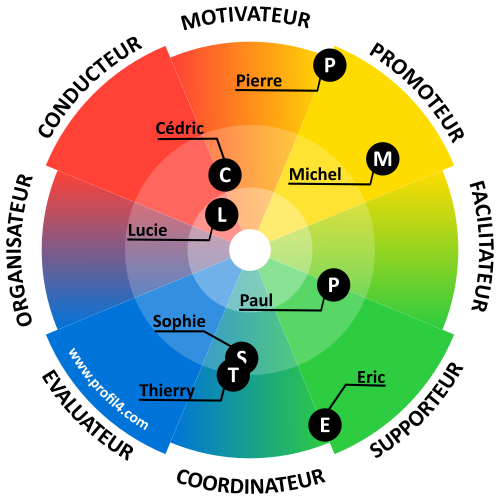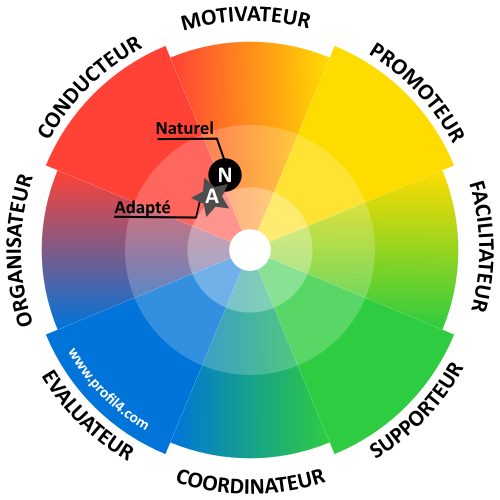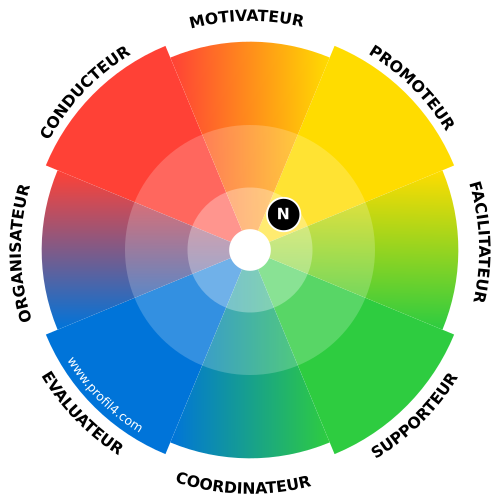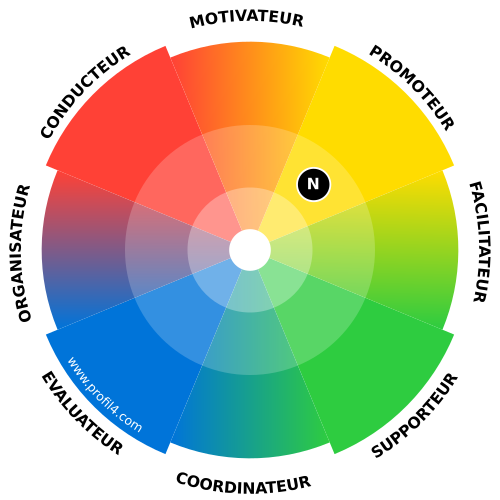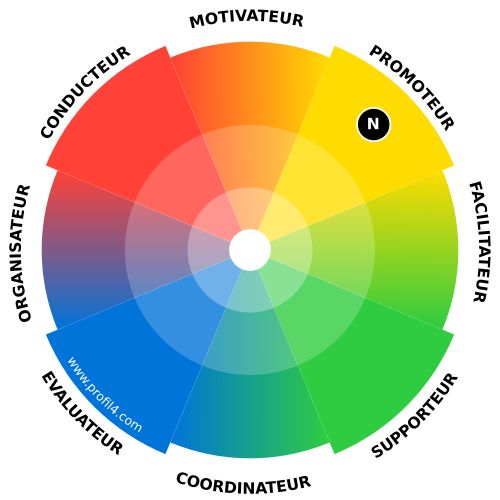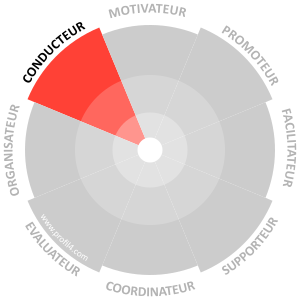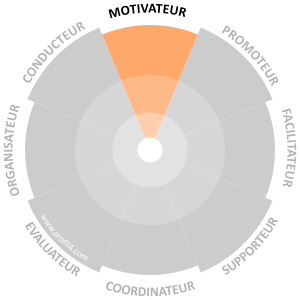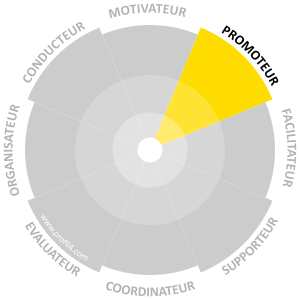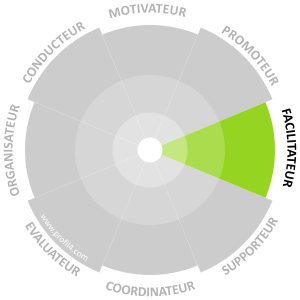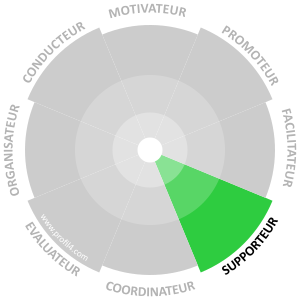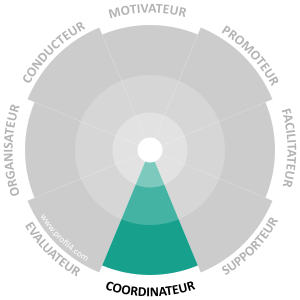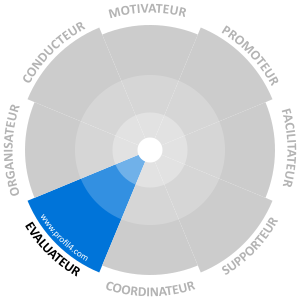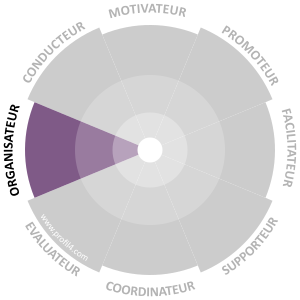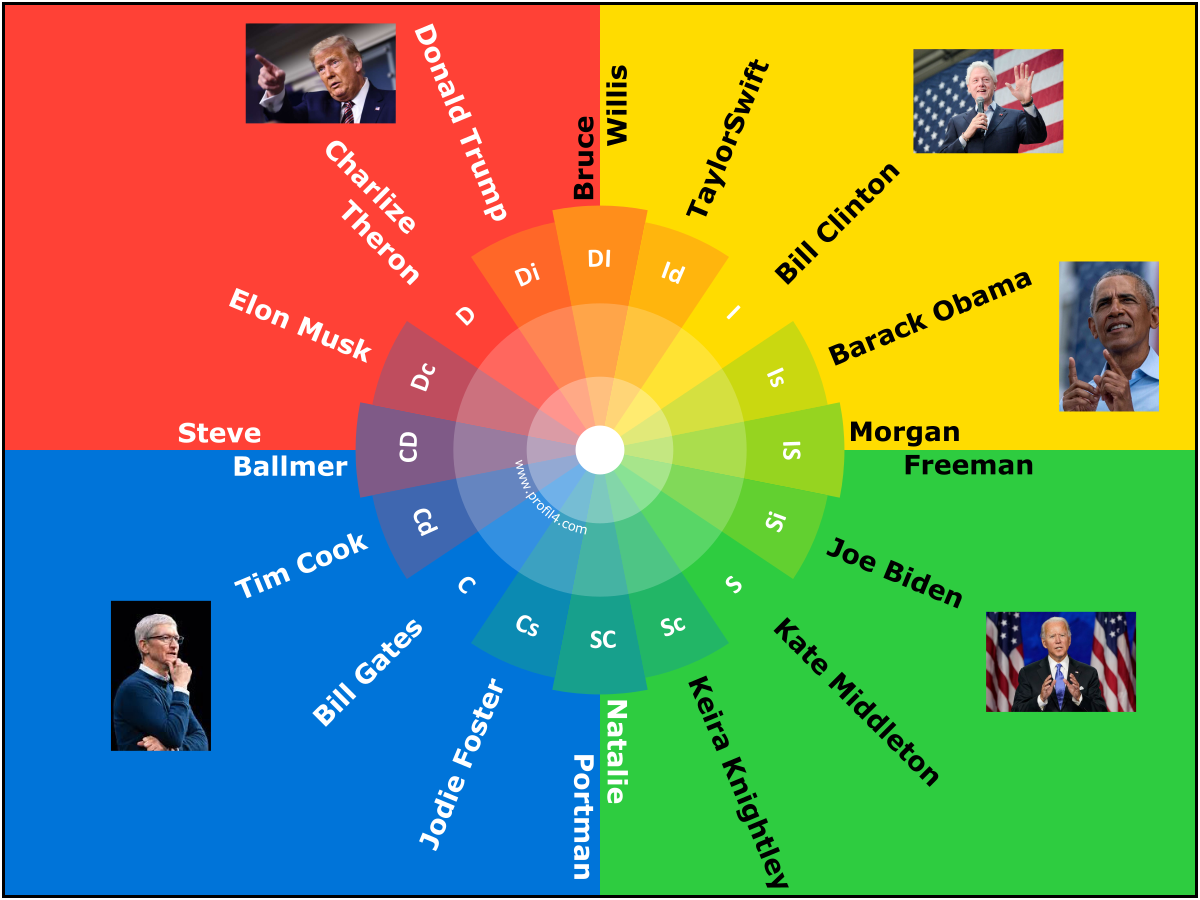The DISC color wheel
Origins of the DISC
The red profile: dominant
The yellow profile: influent
The green profile: stable
The blue profile: Conscientious
8 trends
Communication and Behavior
Motivations - ODAPHIS index
Conflict management
Stress management
Managing mistakes
Improving your sales pitch
Management
At work
Chronoplanning
Vidéos et podcasts
Further research
DISCp4 stands for Dominant, Influential, Stable and Conscientious. These four components can be logically represented on a color wheel divided into four quarters. But to dig deeper or to define a whole team's profile, these results must be refined.
The trends color wheelThis color wheel is made up of eight segments (Conductor, Motivator, Promoter, Facilitator, Supporter, Coordinator, Analyzer and Organizer) and four interlocking rings of increasing size and intensity. The closer someone's profile is positioned to the edges of the wheel, the more the corresponding trend affects them.
By positioning team members' profiles on the trends color wheel, we can figure out the status quo and adapt the ways in which they interact.
Segments and Color Intensity
Profiles are represented by dots (for natural profiles) and stars/squares (for adapted profiles) on the trends color wheel. Someone's position on one of the eight colored segments, corresponding to the 8 trends, defines their profile.
The trends color wheel is further divided into 4 concentric rings, corresponding to weak, moderate or strong profile intensity. Profiles towards the center of the color wheel (the white area) are only slightly affected by the relevant character traits. Profiles towards the outer edge of the color wheel are strongly affected.
Conductor (DD)
Conductors are motivated by getting results and enjoy being tested. They stand out for their ability to take firm, swift decisions, and fully accept their responsibilities. Passionate about challenges, they are bold and determined. Demanding a lot of both themselves and others, they can sometimes appear abrupt in their interactions.
Conductor profiles are located in the red segment of the DISC color wheel, symbolizing dominance. This position reflects their proactive nature and its predominance in the way they make decisions and handle situations generally.
Conductors are renowned for their direct, no-nonsense approach. They are determined, often impatient, and prefer activities that bring immediately visible results. They tackle challenges head-on, and can sometimes appear aggressive in the way they solve problems.
When communicating, Conductors are direct, clear and concise. They prefer to come straight to the point, without getting bogged down in details or superfluous explanations. They use assertive language, often calling on affirmations and commands rather than suggestions.
As leaders, Conductors are decisive and action-oriented. They motivate their teams with their confidence and desire to succeed. They set clear objectives and push their teams to perform at a high level. However, their approach can sometimes be perceived as authoritarian, since they prioritize efficiency and results to the detriment of emotional sensitivity.
To sum up, Conductors make natural, effective and goal-oriented leaders, who favor rapid action and measurable results in all their endeavors.

Motivator (DI)
Motivators are characterized by their extroverted nature and their communication skills, which instil enthusiasm among the members of their teams and their family. Future-oriented, they rely on their intuition to launch new projects and don't hesitate to take risks.
Motivator profiles straddle the red and yellow segments of the DISC color wheel. They benefit from the assertiveness and ambition of Dominant profiles and the optimism and openness of Influential profiles.
Motivators are dynamic and perceptive and often draw people's attention thanks to their natural charisma. They are energetic, competitive and always on the lookout for new experiences and fresh challenges. They handle high-pressure situations well and are able to spur others to action.
When communicating, Motivators are persuasive, often able to captivate and thrill their audience. They use plenty of expressions and gestures to reinforce what they say, making their interactions both engaging and influential.
Motivators are born leaders, capable of pushing teams onward thanks to their enthusiasm and clear vision. Their leadership style is proactive and action-oriented. They are particularly skilled at motivating teams, creating a positive work climate and driving change. However, they need to be careful not to overwhelm others with their sometimes excessively direct style, and to incorporate constructive feedback to maintain a harmonious atmosphere.
Motivator profiles excel in roles that require both leadership and the ability to positively influence others, such as sales, marketing, or indeed any position which requires frequent interaction and strong persuasive skills.

Promoter (II)
Promoters are naturally people-oriented and have a wide social network. Their optimism and warmth enable them to positively influence those around them. Proactive and articulate, they can sometimes be quite talkative.
Promoter profiles are located in the yellow segment of the DISC color wheel. They stand out for their focus on social interaction and their need for recognition.
Promoters are energetic, enthusiastic and always ready to engage in conversation. They stand out for their ability to build relationships and their desire to be the center of attention. Given how much they love human contact, they are often at the heart of social and professional networks, where they can wield their charm and diplomacy.
Their communication style is open, warm and convincing. Promoters use anecdotes and concrete examples to illustrate their points, making their interactions both entertaining and persuasive. They are gifted at public speaking and know how to influence and motivate their audience.
As leaders, Promoters are inspiring and motivating. They excel in roles that require them to galvanize a team, sell an idea or promote a vision. However, they can sometimes lack consistency and follow-through in their projects, requiring support to manage the details and implementation of tasks.
People with this profile are particularly effective in environments which value creativity, networking and personal interaction, such as public relations, marketing, sales or events. Their ability to bring people together and inspire enthusiasm in others is a major asset.

Facilitator (IS)
Facilitators prioritize human relations, encouraging teamwork and the creation of a harmonious work environment. Attentive and tuned-in to others, they make a point of valuing the human element in any interactions.
Facilitator profiles straddle the yellow and green segments of the DISC color wheel. This intersection indicates a unique ability to bring harmony to social interactions while constantly looking out for everyone's well-being.
Facilitators are known for their ability to create and maintain a harmonious work environment. They are good at listening, accessible and frequently prioritize collaboration and consensus. They seek to avoid conflict and foster a positive atmosphere, encouraging open communication and mutual respect.
Their communication style is inclusive and encouraging. They often use open questions to encourage discussion and allow everyone to express themselves. Their ability to actively listen to others helps them understand different viewpoints and find solutions that satisfy everyone involved.
As leaders, Facilitators excel in roles requiring mediation and team coordination. They are gifted at inspiring trust and commitment, and their non-authoritarian approach makes them popular with their colleagues. However, their tendency to favor harmony can sometimes mean they avoid making difficult decisions, especially if this might disrupt the group's ability to get along.
This profile is particularly effective in roles that require working closely with others, such as project management, human resources, or any environment where handling relationships is key to organizational success. Their ability to facilitate dialogue and encourage cooperation is a valuable asset in any context requiring strong team cohesion.

Supporter (SS)
Supporters are guided by their desire for harmony and focus on helping others before they help themselves. They value emotions and communicate calmly, constantly seeking consensus. Their attitude is paternalistic and protective. However, they can be prone to strong emotional reactions when under pressure.
Supporter profiles are located on the green segment of the DISC color wheel. They are characterized by a strong inclination to support others and foster group stability.
Supporters are known for their helpful nature and their willingness to put others' needs before their own. They often act as a pillar within their teams, providing constant support and prepared to help without seeking to dominate or lead in an authoritarian manner.
Their communication style is generally gentle and encouraging. They listen attentively and seek to fully understand problems before putting forward any solutions. Supporters avoid direct confrontation, preferring more subtle, diplomatic ways of resolving conflicts.
As leaders, Supporters are inclusive and consensual. They excel in roles that require maintaining team harmony and motivating coworkers to collaborate effectively. They are less comfortable in situations requiring quick decisions or drastic changes, preferring more measured and well-considered approaches.
Supporters shine in roles that require cohesion and teamwork, such as in healthcare, education, or any position where the support and well-being of others is a priority. Their ability to build and maintain harmonious relationships is a valuable asset for any organization seeking to promote a positive, inclusive culture.

Le Coordinateur (SC)
Coordinators are characterized by their introverted nature and their ability to adapt to their environment. They play an active role in coordinating tasks and are renowned for their reliability. Advocates of diplomacy and cooperation, they place great importance on individual roles and respecting procedures.
Coordinator profiles lie at the junction between the green and blue segments of the DISC color wheel. They are valued for their methodical approach, attention to detail and ability to maintain harmony and order within a team.
Coordinators are renowned for their reliability and systematic approach to tasks. They prefer structured environments and believe in the importance of planning and coordination, ensuring that all aspects of any project are taken into account and properly executed.
Their communication tends to be clear, direct and unambiguous, with a preference for detailed written instructions. Coordinators listen attentively and value clarity and precision in exchanges with others.
As leaders, Coordinators excel in roles that require meticulous management and careful supervision of processes and systems. They are highly skilled at delegating tasks, organizing resources and ensuring that projects meet quality standards and deadlines.
Coordinators are a valuable asset in areas such as administration, project management and logistical operations, where detailed planning and careful execution are essential. Their ability to integrate stability and structure makes them indispensable members of any team, particularly in contexts where precision and conformity are crucial.

Analyzer (CC)
Analyzers are naturally drawn to rules and procedures, demonstrating prudence and caution in their decision-making. They focus on the rational analysis of facts and quantitative data, while setting and adhering to high quality standards. Their approach can sometimes appear methodical or mechanical.
Analyzer profiles are centered on the blue segment of the DISC color wheel. They have a strong inclination towards analysis and caution.
Analyzers are meticulous individuals who prefer to work in a structured, organized environment. They are detail-oriented and make it a point of honor to be accurate and precise in everything they do. Their approach is often conservative, as they prefer tried-and-tested methods to risky new experiments.
Analyzers' communication style is direct and detail-oriented. They think before they speak, often providing full explanations to ensure that their message is accurately understood. They value facts and data in their interactions, and can sometimes appear overly critical or pedantic when correcting inaccuracies.
As leaders, Analyzers prefer approaches based on clearly defined rules and standards. They are effective at maintaining discipline and order and excel in roles that require them to oversee questions of quality and conformity. They make reserved leaders, who are strongly oriented towards operational efficiency and profitability.
Analyzers excel in roles requiring great attention to detail and methodological rigor, such as financial analysis, engineering, scientific research and any field where precision is paramount. Their ability to spot risks and plan accordingly makes them invaluable members of teams where risk management and questions of conformity are essential.

Organizer (CD)
Organizers focus on getting things done, approaching situations and problems with an analytical, result-oriented approach. They stand out for their remarkable organizational skills.
Organizer profiles straddle the blue and red segments of the DISC color wheel. They benefit from a blend of rigor, control and dominance.
Organizers are efficient, precise and action-oriented. They tend to take charge of projects or situations requiring tight control and clear leadership, while ensuring compliance with established standards and rules. Organizers are pragmatic, often perceived as natural leaders and capable of initiating change while maintaining a stable structure.
When communicating, Organizers are direct and straightforward. They favor precise, factual communication to minimize misunderstandings. However, their approach can sometimes be perceived as rigid or overly authoritarian, especially when they are dealing with high-pressure situations or tight deadlines.
Organizers' leadership style is focused on efficiency and productivity. They are very good at strategic planning and the disciplined execution of plans. Able to motivate others by example thanks to their diligence and determination, they put systems and processes in place to ensure success and high quality results.
With their pragmatic, structured approach, Organizers are ideal in roles requiring strict resource management, meticulous planning and the ability to lead teams towards clearly defined objectives.


